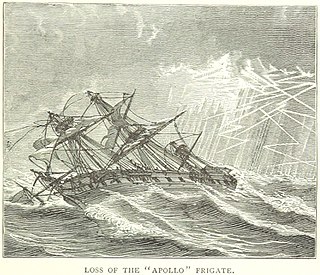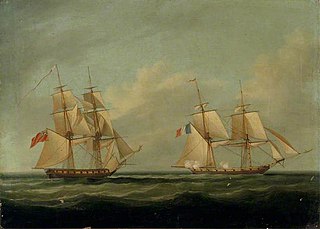HMS Leda, launched in 1800, was the lead ship of a successful class of forty-seven British Royal Navy 38-gun sailing frigates. Leda's design was based on the French Hébé, which the British had captured in 1782. Leda was wrecked at the mouth of Milford Haven in 1808, Captain Honeyman was exonerated of all blame, as it was a pilot error.

HMS Apollo, the fourth ship of the Royal Navy to be named for the Greek god Apollo, was a fifth-rate frigate of a nominal 36 guns. She was the name ship of the Apollo-class frigates. Apollo was launched in 1799, and wrecked with heavy loss of life in 1804.

HMS Bermuda was an 18-gun sloop of the Royal Navy.

HMS Manly was an Archer-class gun-brig launched in 1804. During her career first the Dutch captured her, then the British recaptured her, then the Danes captured her, and finally the British recaptured her again. The British renamed her HMS Bold after her recapture in 1813. She was sold out of service in 1814.

HMS Primrose was a Royal Navy Cruizer-class brig-sloop built by Thomas Nickells, at Fowey and launched in 1807.

HMS Magnet was a Cruizer-class brig-sloop built at Robert Guillaume’s yard at Northam and launched in 1807. She served in the Baltic, where she took two prizes, one an armed privateer, before wrecking in 1809.
During the period of the French Revolutionary and Napoleonic Wars, there were two or three vessels known as His Majesty's hired armed cutter Active that served the British Royal Navy. The reason for the uncertainty in the number is that the size of the vessels raises the possibility that the first and second may have been the same vessel.
HMS Firm was a 12-gun Archer-class gun-brig of the Royal Navy, launched on 2 July 1804. She served in the Channel, where she engaged in one action that would eventually result in her crew qualifying for the Naval General Service Medal. She grounded in 1811 and her crew had to destroy her before abandoning her.
HMS Fama was the Danish brig Fama, of fourteen guns, built in 1802, that the British captured in 1808. She was wrecked at the end of the year.

HMS Seaforth was the French privateer Dame Ernouf, which HMS Curieux captured in 1805. The Royal Navy took her into service, but she foundered later that year.

HMS Grasshopper was a Cruizer-class brig-sloop of the Royal Navy. She was launched in 1806, captured several vessels, and took part in two notable actions before the Dutch captured her in 1811. She then served The Netherlands navy until she was broken up in 1822.
HMS Rapid was an Archer-class gun-brig of 12 guns, launched in 1804. She took part in 1808 in one action that in 1847 the Admiralty recognized with a clasp to the Naval General Service Medal. One month later cannon fire from a shore battery sank her.
HMS Orestes was a mercantile vessel, possible Ann, that the Royal Navy purchased in 1803. She had a short operational career; her crew burnt her in 1805 after she ran aground to prevent the enemy from capturing her.
HMS Autumn was launched at Shields in 1800 as a merchantman. The Royal Navy purchased her in 1801. The Navy sold her in 1815 and she returned to mercantile service. She was lost in 1818.
HMS Volador was an ex-Spanish prize that the Royal Navy acquired in 1807 in the West Indies. Commander Francis George Dickens commissioned her.

HMS Monkey was launched in 1801 at Rochester. She served in the Channel, North Sea, and the Baltic, and was wrecked in December 1810.
HMS Muros was the privateer Alcide, launched at Bordeaux in 1804. The British Royal Navy (RN) captured her in 1806 and commissioned her. She wrecked in March 1808.

HMS Tickler was launched in August 1808 at Brightlingsea as a later Archer-class gunbrig. She served in the Channel and the Baltic until the Danes captured her in 1808 during the Gunboat War. They sold her in 1815. From 1815 to 1852 she sailed as Frederikke Louise, first as a merchantman and then from 1843 to 1851 as a sealer.
HMS Sparkler was launched in 1804 at Brightlingsea. Lieutenant James S.A.Dennis commissioned her in August 1804 for the North Sea.
HMS Fly was launched in March 1804. She was wrecked in March 1805.






